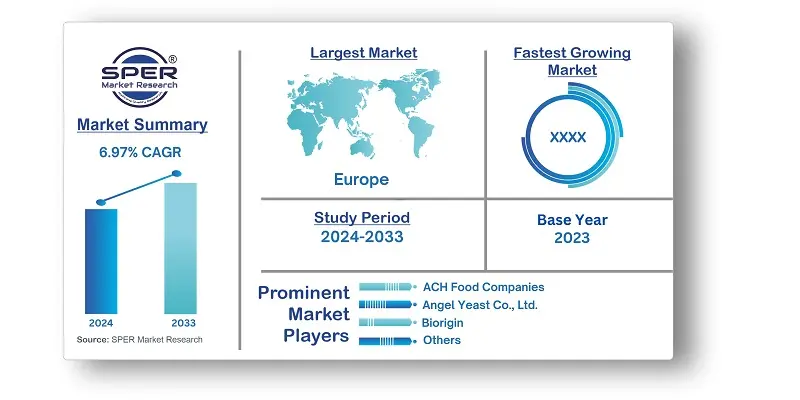
Europe Inactive Dry Yeast Market Growth, Size, Trends, Share, Revenue and Future Outlook
Europe Inactive Dry Yeast Market Size- By Product, By Application- Regional Outlook, Competitive Strategies and Segment Forecast to 2033
| Published: Sep-2024 | Report ID: FOOD2495 | Pages: 1 - 157 | Formats*: |
| Category : Food & Beverages | |||
- In January 2019, Kerry Group introduced "Acryleast," the first non-GMO yeast, which effectively reduces acrylamide levels by 90% without compromising the flavor or texture of food or drink. The company's clean label product line was strengthened by this new introduction.


| Report Metric | Details |
| Market size available for years | 2020-2033 |
| Base year considered | 2023 |
| Forecast period | 2024-2033 |
| Segments covered | By Product, By Application |
| Regions covered | Belgium, France, Germany, Italy, Netherlands, Russia, Spain, Switzerland, Turkey, U.K., Rest of Europe |
| Companies Covered | ACH Food Companies, Inc. (Associated British Foods), Angel Yeast Co., Ltd., Biorigin, Chr. Hansen Holding A/S, Foodchem International Corporation, Kerry Group PLC, Koninklijke DSM N.V., Lallemand, Inc., Lesaffre Group, Pakmaya, Others. |
- Food and Beverage Manufacturers
- Bakery and Confectionery Industry
- Nutraceutical and Dietary Supplement Producers
- Food Service Providers and Restaurants
- Household Consumers
- Animal Feed Manufacturers
| By Product: |
|
| By Application: |
|
- Europe Inactive Dry Yeast Market Size (FY’2024-FY’2033)
- Overview of Europe Inactive Dry Yeast Market
- Segmentation of Europe Inactive Dry Yeast Market By Product (Feed Grade, Food Grade)
- Segmentation of Europe Inactive Dry Yeast Market By Application (Food, Fermentation)
- Expansion Analysis of Europe Inactive Dry Yeast Market
- Problems and Obstacles in Europe Inactive Dry Yeast Market
- Competitive Landscape in the Europe Inactive Dry Yeast Market
- Impact of COVID-19 and Demonetization on Europe Inactive Dry Yeast Market
- Details on Current Investment in Europe Inactive Dry Yeast Market
- Competitive Analysis of Europe Inactive Dry Yeast Market
- Prominent Players in the Europe Inactive Dry Yeast Market
- SWOT Analysis of Europe Inactive Dry Yeast Market
- Europe Inactive Dry Yeast Market Future Outlook and Projections (FY’2024-FY’2033)
- Recommendations from Analyst
1.1. Scope of the report1.2. Market segment analysis
2.1. Research data source2.1.1. Secondary Data2.1.2. Primary Data2.1.3. SPER’s internal database2.1.4. Premium insight from KOL’s2.2. Market size estimation2.2.1. Top-down and Bottom-up approach2.3. Data triangulation
4.1. Driver, Restraint, Opportunity and Challenges analysis4.1.1. Drivers4.1.2. Restraints4.1.3. Opportunities4.1.4. Challenges4.2. COVID-19 Impacts of the Europe Inactive Dry Yeast Market
5.1. SWOT Analysis5.1.1. Strengths5.1.2. Weaknesses5.1.3. Opportunities5.1.4. Threats5.2. PESTEL Analysis5.2.1. Political Landscape5.2.2. Economic Landscape5.2.3. Social Landscape5.2.4. Technological Landscape5.2.5. Environmental Landscape5.2.6. Legal Landscape5.3. PORTER’s Five Forces5.3.1. Bargaining power of suppliers5.3.2. Bargaining power of buyers5.3.3. Threat of Substitute5.3.4. Threat of new entrant5.3.5. Competitive rivalry5.4. Heat Map Analysis
6.1. Europe Inactive Dry Yeast Market Manufacturing Base Distribution, Sales Area, Product Type6.2. Mergers & Acquisitions, Partnerships, Product Launch, and Collaboration in Europe Inactive Dry Yeast Market
7.1. Europe Inactive Dry Yeast Market Size, Share and Forecast, By Product, 2020-20267.2. Europe Inactive Dry Yeast Market Size, Share and Forecast, By Product, 2027-20337.3. Feed Grade7.4. Food Grade
8.1. Europe Inactive Dry Yeast Market Size, Share and Forecast, By Application, 2020-20268.2. Europe Inactive Dry Yeast Market Size, Share and Forecast, By Application, 2027-20338.3. Food8.4. Fermentation
9.1. Europe Inactive Dry Yeast Market Size and Market Share
10.1. Europe Inactive Dry Yeast Market Size and Market Share By Region (2020-2026)10.2. Europe Inactive Dry Yeast Market Size and Market Share By Region (2027-2033)10.3. France10.4. Germany10.5. Italy10.6. Spain10.7. United Kingdom10.8. Rest of Europe
11.1. ACH Food Companies, Inc. (Associated British Foods)11.1.1. Company details11.1.2. Financial outlook11.1.3. Product summary11.1.4. Recent developments11.2. Angel Yeast Co., Ltd.11.2.1. Company details11.2.2. Financial outlook11.2.3. Product summary11.2.4. Recent developments11.3. Biorigin11.3.1. Company details11.3.2. Financial outlook11.3.3. Product summary11.3.4. Recent developments11.4. Chr. Hansen Holding A/S11.4.1. Company details11.4.2. Financial outlook11.4.3. Product summary11.4.4. Recent developments11.5. Foodchem International Corporation11.5.1. Company details11.5.2. Financial outlook11.5.3. Product summary11.5.4. Recent developments11.6. Kerry Group PLC11.6.1. Company details11.6.2. Financial outlook11.6.3. Product summary11.6.4. Recent developments11.7. Koninklijke DSM N.V.11.7.1. Company details11.7.2. Financial outlook11.7.3. Product summary11.7.4. Recent developments11.8. Lallemand, Inc.11.8.1. Company details11.8.2. Financial outlook11.8.3. Product summary11.8.4. Recent developments11.9. Lesaffre Group11.9.1. Company details11.9.2. Financial outlook11.9.3. Product summary11.9.4. Recent developments11.10. Pakmaya11.10.1. Company details11.10.2. Financial outlook11.10.3. Product summary11.10.4. Recent developments11.11. Others
SPER Market Research’s methodology uses great emphasis on primary research to ensure that the market intelligence insights are up to date, reliable and accurate. Primary interviews are done with players involved in each phase of a supply chain to analyze the market forecasting. The secondary research method is used to help you fully understand how the future markets and the spending patterns look likes.
The report is based on in-depth qualitative and quantitative analysis of the Product Market. The quantitative analysis involves the application of various projection and sampling techniques. The qualitative analysis involves primary interviews, surveys, and vendor briefings. The data gathered as a result of these processes are validated through experts opinion. Our research methodology entails an ideal mixture of primary and secondary initiatives.



Frequently Asked Questions About This Report
PLACE AN ORDER
Year End Discount
Sample Report
Pre-Purchase Inquiry
NEED CUSTOMIZATION?
Request CustomizationCALL OR EMAIL US
100% Secure Payment






Related Reports
Our Global Clients
Our data-driven insights have influenced the strategy of 200+ reputed companies across the globe.




















